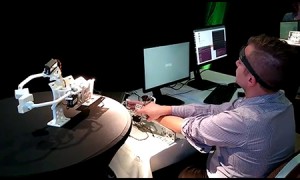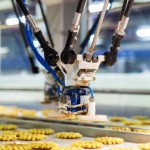Robotic exoskeleton in development to assist stroke patients
 A team from the Essex Innovation Centre, a strategic partnership between the University of Essex and TWI, is currently working with fellow consortium members Generic Robotics and Castalia Innovation on the NeuRestore project which seeks to aid patients that have suffered a stroke, or other ailment that resulted in loss of mobility, by improving their hand and arm movement recovery without the constant need for specialist physiotherapists.
A team from the Essex Innovation Centre, a strategic partnership between the University of Essex and TWI, is currently working with fellow consortium members Generic Robotics and Castalia Innovation on the NeuRestore project which seeks to aid patients that have suffered a stroke, or other ailment that resulted in loss of mobility, by improving their hand and arm movement recovery without the constant need for specialist physiotherapists.
According to SAFE, the Stroke Alliance for Europe, over 13.7 million new strokes happen each year, and statistics have also shown that up to 80% of stroke survivors face upper limb impairment. However, a number of patients can overcome this condition around six months after the incident, even achieving full motor recovery, through neuro-rehabilitation and the brain’s ability to adapt to new incoming information and undertake a form of self-healing called neuroplasticity.
Yet, existing advanced neuro-rehabilitation techniques are faced with a variety of limitations. In order to address this and further support the chances of patient recovery, NeuRestore aims to become a cost-effective (£98k licensed unit/year) and non-invasive brain-computer interface (BCI), specifically tailored for motor rehabilitation of upper limb weakness in stroke survivors without the continuous intervention of specialist physiotherapists.
The NeuRestore consortium were able to commence the project as a result of winning Innovate UK funding in 2019. Each partner is responsible for delivering different parts of the BCI with Generic Robots focusing on constructing a robotic exoskeleton that covers the whole hand and arm, Castalia Innovation developing the virtual reality (VR) component of the project, and the Essex Innovation Centre working on the algorithmic model and the integration with the robotic exoskeleton.
NeuRestore uses relatively inexpensive EEG (electroencephalogram) devices to monitor and record the brain’s electrical patterns while simultaneously receiving trigger feedback or an action output. To achieve a comprehensive picture of cerebral activity, motor imagery (imagining a movement) is employed. With the repetition of mental images of movements, an algorithmic model is calibrated to identify and classify when the patient shows true intention of movement. The trained model is then paired with a robotic hand exoskeleton so that action outputs are generated from classifying the brain signals, and the movement of the robotic fingers is synchronised with them.
The whole process becomes even more immersive when the patient enters a virtual 3D environment where they can see their hand move, providing a more realistic visual output of their imagined movement. This VR dimension can greatly help with building a stronger link between brain signals and subsequent real-life physical movements.
Panos Chatzakos, director of the Essex Innovation Centre, said: “This project is enabled by the complementary expertise and experience of the consortium partners who, together, are combining their knowledge of advanced medical technologies development and application to deliver a brand new support system for stroke patients, that is both affordable and proven effective at making a real difference to people’s recovery.”
















